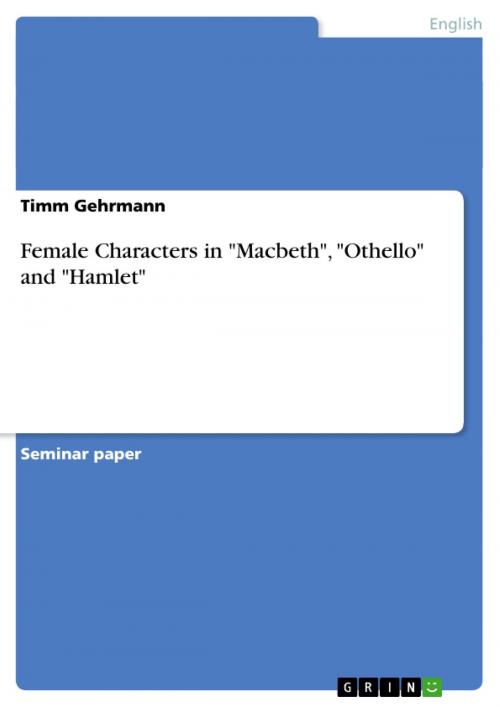Female Characters in 'Macbeth', 'Othello' and 'Hamlet'
Fiction & Literature, Literary Theory & Criticism, British| Author: | Timm Gehrmann | ISBN: | 9783638595155 |
| Publisher: | GRIN Verlag | Publication: | February 19, 2007 |
| Imprint: | GRIN Verlag | Language: | English |
| Author: | Timm Gehrmann |
| ISBN: | 9783638595155 |
| Publisher: | GRIN Verlag |
| Publication: | February 19, 2007 |
| Imprint: | GRIN Verlag |
| Language: | English |
Seminar paper from the year 2006 in the subject English Language and Literature Studies - Literature, grade: 2,0, University of Wuppertal, course: Shakespeare's Late Tragedies, 15 entries in the bibliography, language: English, abstract: Why should one choose to examine the female characters of three of the most prominent Shakespeare plays although men are the protagonists in all of them ? Maybe because one may find certain parallels in the construction of woman characters in these Shakespeare plays which reflect the Elizabethan image of women in general. Maybe because Desdemona, Ophelia and Lady Macbeth are rather tragic figures with a developed character. All main female characters seem to have the same tragic element attached to them - namely their early unnatural death. Potter sees this early death as an erotic quality which seems to be inherent in all of Shakespeare's female characters1. All women seem to have loaded guilt upon them prior to their death. Lady Macbeth is guilty of at least helping in carrying out a murder. Gertrude is guilty of remarrying so quickly after her husband's death. But finding guilt in Desdemona and Ophelia seems rather hard to manage. Desdemona is found guilty by her husband but the audience knows she is not, while Ophelia may be found guilty by the reader to have betrayed Hamlet by not requiting his love. Apart from guilt obedience seems to play a major role in the context of the female characters. Othello wants his wife to be obedient and fears she is not - independent of whether he is present or not - but when he is present he uses force to make her obedient. Ophelia is also very obedient to her brother and her father, which constitutes the falsehood of her character and may thus play a major role in Hamlet's development. Gertrude is obedient to her husband the way a wife is supposed to be obedient. She does not have to be reminded and just blindly follows her husband in her words and deeds until the end of the play. Lady Macbeth may be an eception, but in the light of the reversal of order in Macbeth we may state that Macbeth is the obedient figure when he follows his wife's command. When we consider Macbeth to be a photonegative of the world we can find the obedience motive again. One may argue that when a lack of obedience persists 'chaos is come again' which is exactly the consequence of all acts of disobedience of women in the three plays. The three witches who are not obedient to anyone, Lady Macbeth and the consequences of Desdemona's felt disobedience may serve as an example for the consequences of female disobedience.
Seminar paper from the year 2006 in the subject English Language and Literature Studies - Literature, grade: 2,0, University of Wuppertal, course: Shakespeare's Late Tragedies, 15 entries in the bibliography, language: English, abstract: Why should one choose to examine the female characters of three of the most prominent Shakespeare plays although men are the protagonists in all of them ? Maybe because one may find certain parallels in the construction of woman characters in these Shakespeare plays which reflect the Elizabethan image of women in general. Maybe because Desdemona, Ophelia and Lady Macbeth are rather tragic figures with a developed character. All main female characters seem to have the same tragic element attached to them - namely their early unnatural death. Potter sees this early death as an erotic quality which seems to be inherent in all of Shakespeare's female characters1. All women seem to have loaded guilt upon them prior to their death. Lady Macbeth is guilty of at least helping in carrying out a murder. Gertrude is guilty of remarrying so quickly after her husband's death. But finding guilt in Desdemona and Ophelia seems rather hard to manage. Desdemona is found guilty by her husband but the audience knows she is not, while Ophelia may be found guilty by the reader to have betrayed Hamlet by not requiting his love. Apart from guilt obedience seems to play a major role in the context of the female characters. Othello wants his wife to be obedient and fears she is not - independent of whether he is present or not - but when he is present he uses force to make her obedient. Ophelia is also very obedient to her brother and her father, which constitutes the falsehood of her character and may thus play a major role in Hamlet's development. Gertrude is obedient to her husband the way a wife is supposed to be obedient. She does not have to be reminded and just blindly follows her husband in her words and deeds until the end of the play. Lady Macbeth may be an eception, but in the light of the reversal of order in Macbeth we may state that Macbeth is the obedient figure when he follows his wife's command. When we consider Macbeth to be a photonegative of the world we can find the obedience motive again. One may argue that when a lack of obedience persists 'chaos is come again' which is exactly the consequence of all acts of disobedience of women in the three plays. The three witches who are not obedient to anyone, Lady Macbeth and the consequences of Desdemona's felt disobedience may serve as an example for the consequences of female disobedience.















